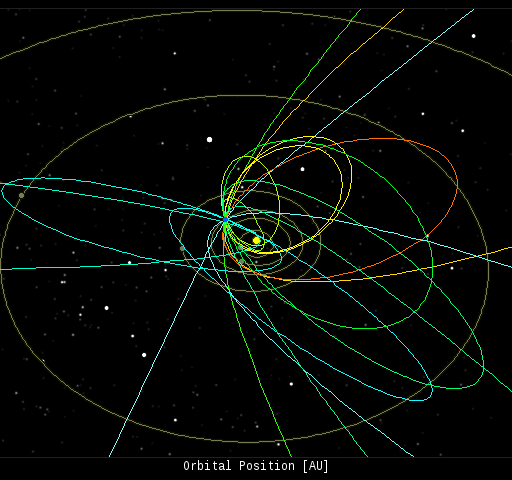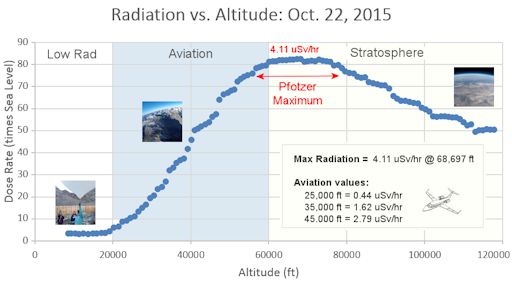Marianne's Heaven On Earth Aurora Chaser Tours Chasethelighttours.co.uk invites you to join them in their quest to find and photograph the Aurora Borealis. Experience the winter wonderland in the Tromsø Area. | | | ASTEROID TO BUZZ EARTH: A small asteroid named "2013 TX68" will fly by Earth on March 5th, and NASA says it could come as close as 17,000 km to our planet's surface. That would put it well inside the Clarke Belt of geosynchronous satellites. The space rock is about 30 meters wide, or 50% larger than the asteroid that broke up in the atmosphere over Chelyabinsk, Russia, three years ago. If an asteroid the size of 2013 TX68 were to enter Earth's atmosphere, it would likely produce an air burst with twice the energy of the Chelyabinsk event. Get the full story from NASA. OZONE HOLE FORMS OVER THE UK: For the past week, sky watchers in the UK have witnessed a rare apparition of polar stratospheric clouds (PSCs). Normally restricted to the Arctic Circle, the fantastically colorful clouds have appeared over the British Isles almost every day since Jan. 31st. Colin Fraser photographed the display over Edinburgh, Scotland, on Feb. 2nd: 
PSCs form in the lower stratosphere when temperatures drop to a staggeringly-cold -85ºC. High-altitude sunlight shining through tiny ice particles ~10µm wide produce bright iridescent colors by diffraction and interference. But there is more to PSCs than ice. Some polar stratospheric clouds contain very small droplets of naturally occurring nitric and sulphuric acids. These droplets destroy ozone. Indeed, atmospheric optics expert Les Cowley points out that a temporary ozone hole has formed over Ireland and the UK. It is the blue patch in this Feb. 1st ozone map from NASA's Arctic Ozone Watch: 
"The acid droplets destroy the stratospheric ozone layer that protects us from harmful solar ultra-violet rays," says Cowley. "They catalyse unreactive forms of man-made chlorine into active free radicals (for example ClO, chlorine monoxide). The radicals destroy many ozone molecules in a series of chain reactions.." This outbreak of PSCs is truly unusual. "Prior to this outbreak I have seen PSCs over the UK only twice in the last 20 years!" says Cowley. "This episode is exceptional at such low latitudes. If it goes on any longer my camera will be worn out." UPDATE: On Feb. 5th, the outbreak of PSCs has subsided, and so has the UK ozone hole. Click here for updates. Realtime Stratospheric Cloud Photo Gallery MORNING PLANETS: Something special is about to happen in the morning sky. On Feb. 6th and 7th, the crescent Moon will join Mercury and Venus, forming a bright triangle in the rosy glow of dawn. This morning, Tom J. Martinez of Pueblo West, Colorado, photographed the Moon en route to the convergence: 
"I created a nine-panel panorama which shows all five planets now visible in the morning sky: Mercury, Venus, Saturn, Mars and Jupiter," says Martinez. "It was a beautiful view." And the view is about to improve. Set your alarm for dawn and look east into the sunrise. It's a great way to start the day. [sky map] Realtime Spaceweather Photo Gallery
Realtime Aurora Photo Gallery
Realtime Comet Photo Gallery Every night, a network of NASA all-sky cameras scans the skies above the United States for meteoritic fireballs. Automated software maintained by NASA's Meteoroid Environment Office calculates their orbits, velocity, penetration depth in Earth's atmosphere and many other characteristics. Daily results are presented here on Spaceweather.com. On Feb. 5, 2016, the network reported 16 fireballs.
(16 sporadics)  In this diagram of the inner solar system, all of the fireball orbits intersect at a single point--Earth. The orbits are color-coded by velocity, from slow (red) to fast (blue). [Larger image] [movies] Potentially Hazardous Asteroids ( PHAs) are space rocks larger than approximately 100m that can come closer to Earth than 0.05 AU. None of the known PHAs is on a collision course with our planet, although astronomers are finding new ones all the time. On February 5, 2016 there were potentially hazardous asteroids. Notes: LD means "Lunar Distance." 1 LD = 384,401 km, the distance between Earth and the Moon. 1 LD also equals 0.00256 AU. MAG is the visual magnitude of the asteroid on the date of closest approach. | | Cosmic Rays in the Atmosphere | | Situation Report -- Oct. 30, 2015 | Stratospheric Radiation (+37o N) | | Cosmic ray levels are elevated (+6.1% above the Space Age median). The trend is flat. Cosmic ray levels have increased +0% in the past month. | | Sept. 06: 4.14 uSv/hr (414 uRad/hr) | | Sept. 12: 4.09 uSv/hr (409 uRad/hr) | | Sept. 23: 4.12 uSv/hr (412 uRad/hr) | | Sept. 25: 4.16 uSv/hr (416 uRad/hr) | | Sept. 27: 4.13 uSv/hr (413 uRad/hr) | | Oct. 11: 4.02 uSv/hr (402 uRad/hr) | | Oct. 22: 4.11 uSv/hr (411 uRad/hr) | These measurements are based on regular space weather balloon flights: learn more. Approximately once a week, Spaceweather.com and the students of Earth to Sky Calculus fly "space weather balloons" to the stratosphere over California. These balloons are equipped with radiation sensors that detect cosmic rays, a surprisingly "down to Earth" form of space weather. Cosmic rays can seed clouds, trigger lightning, and penetrate commercial airplanes. Our measurements show that someone flying back and forth across the continental USA, just once, can absorb as much ionizing radiation as 2 to 5 dental X-rays. For example, here is the data from a flight on Oct. 22, 2015: 
Radiation levels peak at the entrance to the stratosphere in a broad region called the "Pfotzer Maximum." This peak is named after physicist George Pfotzer who discovered it using balloons and Geiger tubes in the 1930s. Radiation levels there are more than 80x sea level. Note that the bottom of the Pfotzer Maximim is near 55,000 ft. This means that some high-flying aircraft are not far from the zone of maximum radiation. Indeed, according to the Oct 22th measurements, a plane flying at 45,000 feet is exposed to 2.79 uSv/hr. At that rate, a passenger would absorb about one dental X-ray's worth of radiation in about 5 hours. The radiation sensors onboard our helium balloons detect X-rays and gamma-rays in the energy range 10 keV to 20 MeV. These energies span the range of medical X-ray machines and airport security scanners. | | The official U.S. government space weather bureau | | | The first place to look for information about sundogs, pillars, rainbows and related phenomena. | | | Researchers call it a "Hubble for the sun." SDO is the most advanced solar observatory ever. | | | 3D views of the sun from NASA's Solar and Terrestrial Relations Observatory | | | Realtime and archival images of the Sun from SOHO. | | | from the NOAA Space Environment Center | | | the underlying science of space weather | | 
